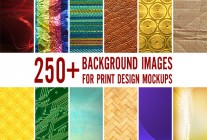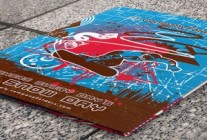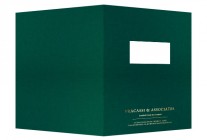
The next time you want to shut down some smug jerk who says that print design is dead, just throw these two words at them: wedding invitations.
In a world where most of our events are planned through e-vites, text messages and social media, paper invitations are still the only socially acceptable way to invite someone to your wedding. As a print designer, working in the wedding industry can be a lucrative opportunity—but it comes with its own unique set of pitfalls and problems. And if you’re a bride or groom designing your own wedding invitations, you’re likely to run into a whole host of issues without any design experience to guide you.
We put together this handy guide and graphic to help you learn how to navigate the wedding industry and design custom wedding invitations that will make this special day even more memorable.
Bring in the branding

When you really think about it, each wedding ceremony has a unique brand identity. The couple chooses a visual theme to represent the entire event, and the wedding invitation designs are only a small part of that. There are a million different factors surrounding the wedding itself that could end up informing your invitation design—from the icing on the wedding cake to the groom’s boutonniere.
You need to understand how the invitations will factor in with the rest of the ceremony’s “brand identity.” But since wedding invites are sent out months before the wedding, a lot of those details may not yet be finalized. If all anyone knows are the broad strokes (like the overall theme and style the couple wants), your invitation design will kick off the wedding’s “branding.” It’ll be the first taste that wedding guests have of the special occasion.
But the kind of brand identity a designer would create for a professional brand is going to be different than the one you create for a wedding. For starters, you might want to create a “logo” that can be used in all of the printed objects tied to the wedding. But what works for a company’s logo won’t quite work for a wedding. You might find our post on how to create two letter logos a helpful start.
A wedding logo is more like an icon that represents the wedding and ties each of the different components together. That could be something like a lettermark, an illustration or even just a photo of the couple—whatever works as a visual connection to the rest of the wedding. Think of the way a logo in a branding kit creates consistency between different pieces of collateral. A wedding has just as many pieces of collateral, so there has to be something to connect them all together, be it color, imagery or even just using the same font and paper choices.
Know your wedding culture
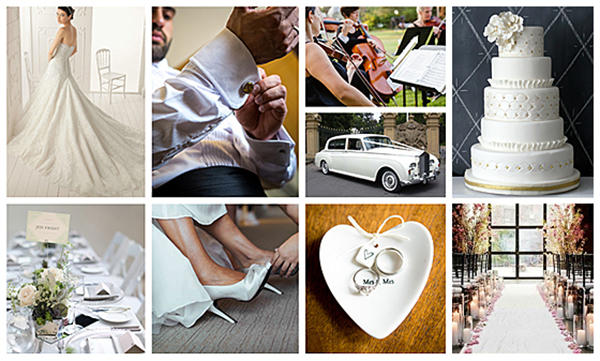
If you’re designing wedding invitations, then like it or not, you’re a part of the wedding industry, and that means you need to stay abreast of the latest trends. It wouldn’t hurt to pick up a few bridal magazines, or at least check in on wedding blogs and Pinterest boards. You’ll find plenty of inspirations in these places that apply exclusively to wedding design, as opposed to design at large.
But the other important reason to stay in tune with wedding culture is because it provides valuable guidance. When you have questions, you’ll have somewhere to look for answers. And having answers is important even if you aren’t the one getting married. When you’re a designer working for clients, they may have questions for you that have nothing to do with print design or wedding invitations; they’ll see you as a wedding professional with valuable input.
So when you’re designing professionally, it’s a good idea to become the best wedding expert you can be so that you can field any questions that pop up. Otherwise, you may become lost in a sea of wedding what-ifs. Or you might lose some credibility, which could complicate things further on if your client adopts an “I-know-better-than-you” attitude.
Know the couple’s story
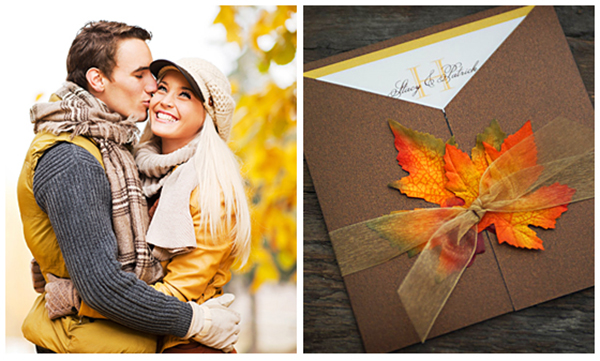
Unfortunately, most couples aren’t going to have a nice convenient branding book or marketing strategy to help guide everything in the right direction. In fact, a lot of couples are just sort of planning as they go. You’re going to have to spend a little time at the start of the project getting to know the couple. Find out who they are, what they like and what they want out of their wedding invitations.
Most of all, you want to know their story and how your invitations can be a part of it. Just like professional corporate brands, every couple comes with their own message and values. But where a brand will spend time defining their message, a romantic couple doesn’t always understand what works about their relationship—they just live it.
Spend some time coaxing out the story behind the invitation. If you’re designing for yourself, talk to your partner about an event, place or quote that’s important to both of you and try to think of ways to incorporate it into your invitations. If you’re a designer working with clients, a good way to get the information you need is to write up a questionnaire and follow it up with a creative brief so that both parties fully understand the details.
Choosing a style
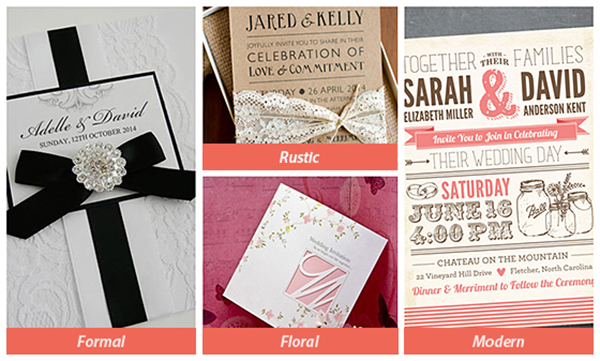
There was a time when wedding invitations were almost entirely text, with maybe a few additions to make them visually appealing. Nowadays, they’re as diverse as any other form of print collateral. Every couple wants their wedding to be special and unique, so they’ll want the style of their invitations to match the style of their ceremony and their personal tastes as a couple.
That might mean a traditional text-only invitation in a scripted or classic font. But it could also mean a custom comic strip with the couple dressed as superheroes and battling zombies. There’s a whole world of options to choose from. Chances are that you’re going to have ideas in mind before you even start designing.
But don’t sweat it if somebody in the design process gets analysis paralysis. A lot of couples have trouble making up their minds—and with so many options, who can blame them? It’s okay to ask for outside help if you’re not sure how to design your own wedding invite. For designers, it’s a good idea to have some examples to show your clients so you can help narrow down what they’re looking for.
Whatever the situation is, make sure that you and your clients—or you and your partner—are on the same page. Otherwise, your idea of what constitutes a “classic” design might be different from what they expected.
Design with emotion first

We’ve said before that when you’re selling your design ideas to a professional client, it doesn’t actually matter if they like your design so long as the design works for their brand’s needs and will captivate the target audience.
When it comes to designing wedding invitations, forget all that.
In this case, the client and the target audience are one and the same. It doesn’t matter if you have the best design in the world; if the bride or the groom doesn’t like it, the design won’t fly. Wedding invitations commemorate one of the most important days in a couple’s lives. They will most likely want to hold onto their invitations forever, to put them in frames, scrapbooks or wedding albums. This strong emotional connection means you’re not always going to be able to tackle these projects with pure logic. You need to be intuitive, open to ideas and most of all, flexible.
Weddings can be a stressful, emotional time for everyone, and sometimes that negativity can be directed outward at anyone involved in the event. And we’re not just talking about “bridezillas” here—grooms can be just as high-strung, and so can close family and friends. Even the calmest, most laidback couples are likely to have some jitters. If you’re part of the wedding party, breathe, relax and take a break. You can work on the wedding invitations once you’re feeling a little calmer.
As a designer, you should be prepared to deal with your clients’ feelings. You might even find yourself in the middle of a spat between a couple who can’t decide on what to do, so prepare for these stressful moments and do everything you can to reduce the stress of your clients. You are going to have clients who absolutely freak out on you for no reason—learn to roll with the punches.
Remember that many of your wedding clients have probably never worked with a professional print designer before, so you’re going to have to be patient and show them the ropes. Of course, you also need to protect yourself against clients from hell and learn to walk away from a wedding project when the work relationship becomes too toxic.
Use templates the right way
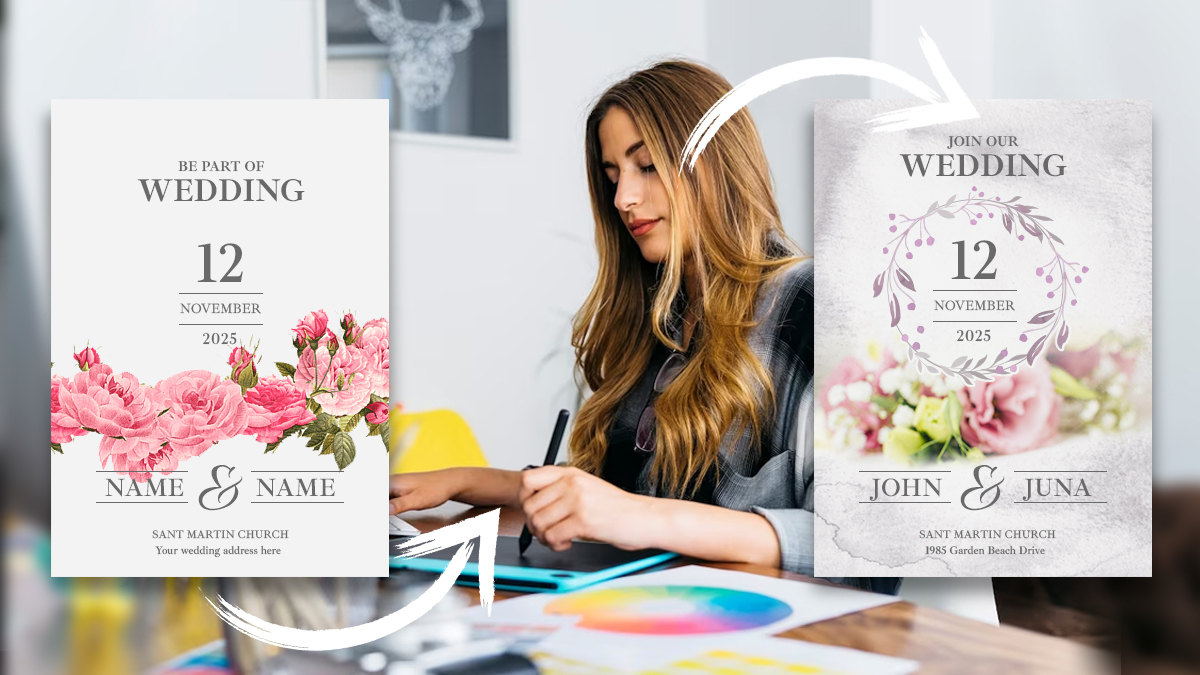
Design templates can be a great tool when you’re designing wedding invitations, especially if you haven’t done a lot of wedding collateral before. Plenty of couples adopt a DIY attitude when it comes to their wedding invitations, and they use plug-and-print sites to save some money. But here’s the thing—the most popular templates are reused so often, the wedding guests can smell a template a mile away.
On top of that, using a template is kind of like saying that the couple’s wedding day is going to be just like every other couple’s wedding day, when what they really want is something truly unique because they’re not like any other couple.
The good news is that designing a custom invitation doesn’t have to be super complicated. And you can still use a template—at first. Starting from a template is a good way to pick a style and even a layout. But once you’ve got those things settled, it’s time to start modifying the design. A wedding is a once in a lifetime experience, so couples who can afford it are sometimes willing to spend a little more on their invitations if it means getting something that’s truly one of a kind. That means you can pull out all the bells and whistles and do things you couldn’t normally do for a professional design.
You may even want to think about creating your own unique wedding invitation templates. You could sell them as resources on design websites and make a little money on the side. Or you can keep them for your own use, so that you can present your friends or future clients with unique template choices for their invitations that they can’t find anywhere else. This allows you to save a little time while still providing your clients with something they haven’t seen before.
Select a color scheme
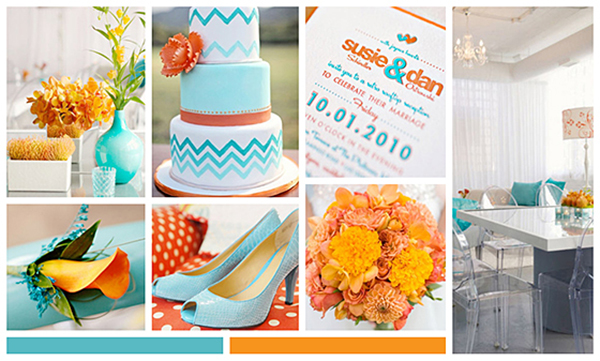
Just like a professional client, most couples will come with their own color branding, too. If they haven’t already chosen a color scheme for their wedding, they will finalize it when ordering invitations. Unfortunately, you won’t always have Pantone swatches that perfectly match the wedding colors, so you’ll have to try and match as closely as possible.
This means actually having samples printed out and ready to be approved. There’s always the risk of color discrepancies when you print on colored stock or use four-color process, so make sure all colors are finalized with the couple before you send them off to print.
Using Pantone colors is a wise choice, since you’ll learn quickly enough that there’s always more than just the invitation to consider. By using a PMS spot color, you can ensure color consistency throughout all the pieces of print collateral. And it can also save a little money, since you’ll be able to use fewer ink colors.
Use appropriate fonts
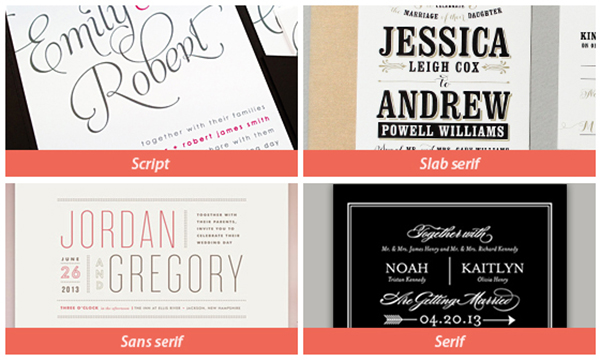
The process of choosing fonts for a wedding invitation design is pretty much the same as any other print design. You want to pick a font that matches the theme while grabbing the audience’s attention. But legibility is something to watch out for, especially when working with fancy script fonts. Fonts with a lot of thin, overlapping lines can have considerable ink bleed when printed in small sizes.
You also have to watch out for licensing issues when it comes to the fonts you select. If you are designing your own wedding invitations or providing free design services for friends and family, then the fonts you use are covered under personal use licensing. But if you’re charging money for your designs, you’ll need a commercial license for all the fonts you use, even though a wedding invitation isn’t considered commercial print collateral. A good rule of thumb to follow is that whenever you are getting paid to design something, it counts as a commercial design job. Most couples probably won’t want to eat the cost of a font license, so stick to free fonts or ones you already own.
And be advised—many couples like to incorporate handwritten calligraphy into their wedding invitations, either on the envelope or as part of the invitation itself. If you’re not an expert calligrapher, it might be a good idea to team up with someone who is. It’ll be easier if you can find someone to provide this service in some way, since that’s one less thing the newlyweds will have to stress over.
Adding illustrations and photos
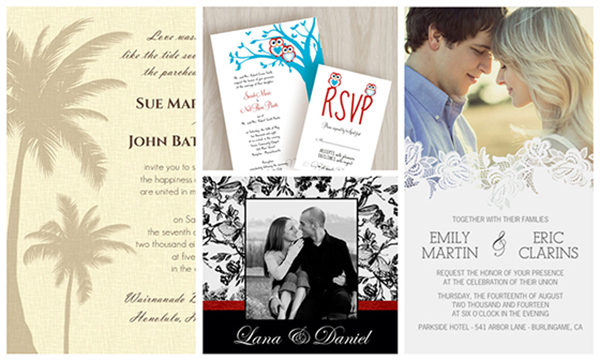
When using stock photography or illustrations in your wedding invitation designs, the same rules apply as fonts—if you’re getting paid to do the design, you’ll need a commercial license. Stick to the high-quality vector side of stock illustration and avoid anything that looks too much like clip art. You’re not trying to call attention to some local business’s fire sale; you’re talking to invited guests about people they already know and love.
That means you’ll rarely use stock photography at all, except for maybe a few photos of wedding-related items like champagne flutes, rings, flowers and so on. Even then, a lot of couples prefer custom photos, and since their champagne flutes, rings and flowers probably haven’t been ordered yet, you’ll likely end up using photos of the couple themselves.
Fortunately for you, most couples will already have photos for just such an occasion, be they engagement photos or just snapshots that the couple has an emotional connection to. Professional-level photographs probably won’t need any retouching, but there may be a situation where the couple has an old, low-quality photo that means a lot to them. Be prepared to give any photos a quick looksee to make sure they’re up to snuff. Worst case scenario, you’ll have to find a way to take a grainy cell phone photo and use an AI solution to make it look professional.
Photo invitations are becoming popular, not just because they’re more personalized, but because they’re an easy and cheap option for DIY couples. That means you might need to go above and beyond with your photo invitations to stand out from the plug-and-print crowd. For example, adding custom die cuts or using different paper coatings are great ways to give a design a unique edge.
Appeal to the sense of touch
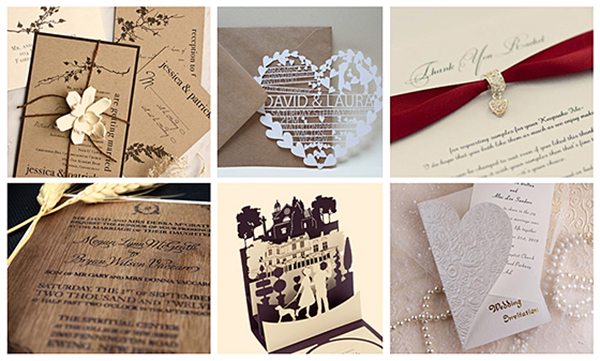
We’ve said it before and we’ll say it again—touch is an important aspect of print design, and the type of paper stock you choose can have a dramatic impact. Wedding invitations are meant to be timeless—not always in terms of visual design, but at least in durability. Couples are likely to hold on to them as mementos for years to come, so they’ll want them to feel thick and strong.
That’s why it’s common for wedding invitations to be printed on heavy cardstock, often textured stock. If it doesn’t have that heavy, weighted feel, it’s going to seem cheap.
The more the wedding guests—and the couple getting married, for that matter—can experience the invitation through their sense of touch, the more they’ll build an emotional connection to it. That means everything you can do to create a unique tactile experience is on the table.
Foil stamping, embossing and debossing effects are common imprint methods for wedding designs, not only because they create an elegant look, but because they add textural variety. Don’t be afraid to break away from the typical size and shape, either—use custom die-cuts (such as a delicate doily-style border) to dazzle wedding goers with a truly unique invitation.
A wedding invitation is more than just one piece of paper
If you thought you were just going to be designing one little piece of paper, then you’ve obviously never been invited to a wedding. The term “wedding invitation” is sort of a misnomer because what you’re essentially designing is a wedding brand kit, with the invitation at the center.
Make no mistake—the invitation itself is still the star of the show. But you’re going to be responsible for all of the players, too.
Invitation accessories
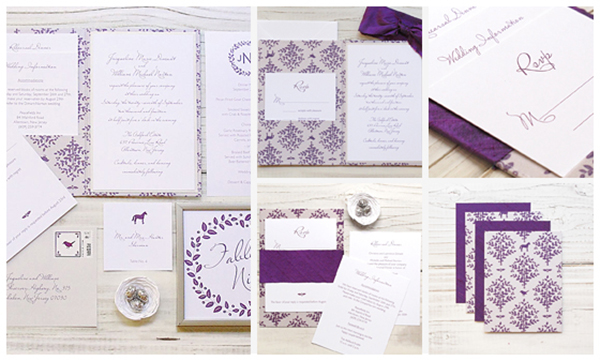
At minimum, you’ll also need to include an RSVP card so that guests can respond to the invitation. RSVP cards often have a design that’s very similar to the invitation, though they do come with unique considerations of their own. (Here’s a little tip: add a little number on the back of the card that corresponds to that person’s name on the guest list, just in case they forget to include their name when they RSVP.)
But many wedding invitation packets also include things like maps to the reception, dinner menus, wedding registry information and hotel accommodations.
There’s also all the stuff that comes before the wedding—most couples send save-the-date invitations, which are typically a single sheet or postcard with just the pertinent information that goes out before the formal invitation. You may even create a design for the engagement announcement, or invitations for the wedding shower and bachelor/bachelorette parties. And when the wedding is over, the couple is naturally going to want to send out thank you cards to their guests.
So when you design a wedding invitation, you really do need to treat it like a branding kit, since you’ll have multiple components that all need to work together to create an overall theme. And that’s just what you’ll find inside—there’s also the outside packaging to consider.
Invitation Card Envelopes
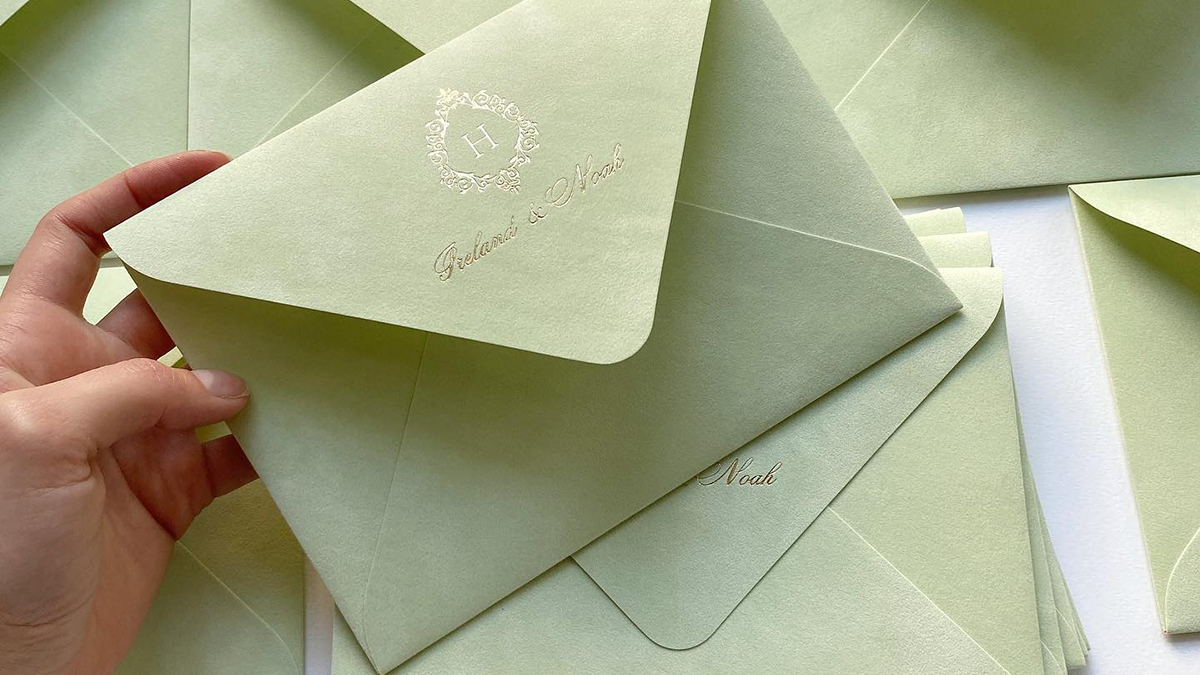
Unless the bride and groom went to Hogwarts and their wedding invitations are going to be delivered by a whimsical snow owl, they’re going to have to take their chances with the postal service. The invitations will need envelopes, and those envelopes should have custom elements that tie into what’s inside. Recipients should be able to look at the envelope and immediately recognize that it’s a wedding invitation and not junk mail.
Even better—they should get a sense of whose wedding it is before they even open it up (or read the return address). At the very least, the envelope should match the color scheme, but you can also create a completely custom envelope design to better integrate with the invitation.
If you don’t want to go the fully-customized route for something as disposable as an envelope, design some custom return address labels or stickers that the couple can use to seal it. This is an inexpensive way to bring a custom feeling to standard envelopes.
Don’t forget that most wedding invitation packages come with a second envelope inside so that guests can send back their RSVP cards. This is another area where custom address labels can come in handy to provide a little bit of uniqueness for an inexpensive cost.
Depending on the size, shape and amount of contents inside the wedding kit, you may have to design custom-sized envelopes or even custom packaging and presentation boxes to be able to send it all through the mail. When in doubt, check with your local post office to ensure that your custom printed envelopes and packages are mail-ready.
At the wedding itself
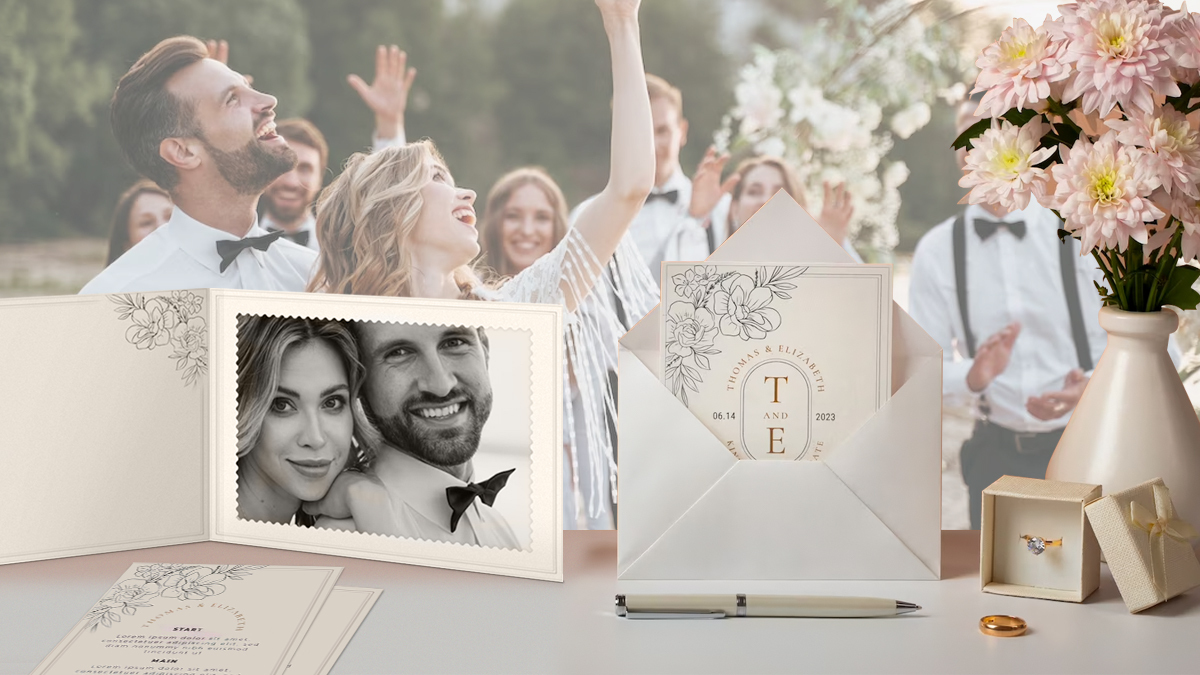
After you’ve gone through all the work of designing an entire wedding invitation kit, complete with envelopes and packaging, you might as well take it all the way and take care of all the wedding’s print design needs. The wedding ceremony and reception will also require different types of print collateral such as programs, table settings, menus and general signage.
Some couples may also want to provide some printed gifts for their guests to take home as party favors. For example, many couples have photo booths at their weddings and like to give their guests commemorative photo folders to take their photos home safely .
This is where having a brand kit mentality will really pay off. If you know ahead of time that you’re going to provide more than just wedding invitations, you can plan your design scheme accordingly so that the theme carries through in every piece.
Download and share this wedding invitation design advice

This work by Company Folders, Inc. is licensed under a Creative Commons Attribution 4.0 International License.
Embed this graphic on your site
One final tip
As always, we encourage print designers to build a good relationship with a reputable print shop—especially when working with wedding clients. The less hoops your clients have to jump through, the less stressed they’ll be, so taking the printing off of their hands will keep them happier in the long run. And establishing a good relationship with a printer could mean more work opportunities and referrals for you.
Even if you’re designing your own invitations, visiting a print shop to learn more about customizable options is a good idea. And if you find a good print shop, then you’ll be able to recommend it to your family and friends who are getting married.
Do you have any tips for creating custom wedding invitations that you’d like to share with your fellow designers? Have any horror stories from working with wedding clients? Leave a comment below and let’s talk weddings!





